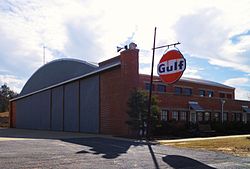Tuskegee Airmen National Historic Site
|
Tuskegee Airmen National Historic Site
Tuskegee Institute Field #2 Moton Field |
|

The Hangar One Museum at The Tuskegee Airmen National Historic Site at Moton Field in Tuskegee, Alabama
|
|
|
Location of Tuskegee Airmen National Historic Site
|
|
| Location | Tuskegee, Alabama, USA |
|---|---|
| Coordinates | 32°27′33″N 85°40′48″W / 32.45917°N 85.68000°WCoordinates: 32°27′33″N 85°40′48″W / 32.45917°N 85.68000°W |
| Built | 1940 |
| Architect | U.S. Army |
| Website | Tuskegee Airmen National Historic Site |
| NRHP Reference # | 01000284 |
| Significant dates | |
| Added to NRHP | November 6, 1998 |
| Designated NHLD | November 6, 1998 |
Tuskegee Airmen National Historic Site, at Moton Field in Tuskegee, Alabama, commemorates the contributions of African American airmen in World War II. Moton Field was the site of primary flight training for the pioneering pilots known as the Tuskegee Airmen, and is now operated by the National Park Service to interpret their history and achievements. It was constructed in 1941 as a new training base. The field was named after former Tuskegee Institute principal Robert Russa Moton, who died the previous year.
Before 1940, African Americans were barred from flying for the U.S. military. Civil rights organizations and the black press exerted pressure that resulted in the formation of an all African-American pursuit squadron based in Tuskegee, Alabama, in 1941. They became known as the Tuskegee Airmen.
"Tuskegee Airmen" refers to all who were involved in the so-called "Tuskegee Experiment," the Army Air Corps program to train African Americans to fly and maintain combat aircraft. The Tuskegee Airmen included pilots, navigators, bombardiers, maintenance and support staff, instructors, and all the personnel who kept the planes in the air.
The military selected Tuskegee Institute to train pilots because of its commitment to aeronautical training. Tuskegee had the facilities, and engineering and technical instructors, as well as a climate for year-round flying. The first Civilian Pilot Training Program students completed their instruction in May 1940. The Tuskegee program was then expanded and became the center for African-American aviation during World War II.
The Tuskegee Airmen overcame segregation and prejudice to become one of the most highly respected fighter groups of World War II. They proved conclusively that African Americans could fly and maintain sophisticated combat aircraft. The Tuskegee Airmen's achievements, together with the men and women who supported them, paved the way for full integration of the U.S. military.
Moton Field was the only primary flight facility for African-American pilot candidates in the U.S. Army Air Corps (Army Air Forces) during World War II. It was named for Robert Russa Moton, second president of Tuskegee Institute.
...
Wikipedia


